Amino Acid vs. Imino Acid — What's the Difference?
By Tayyaba Rehman — Published on January 31, 2024
Amino acids are organic compounds with both amine (-NH2) and carboxyl (-COOH) groups, essential for protein synthesis. Imino acids have an imino group (-NH-) instead of an amine group.

Difference Between Amino Acid and Imino Acid
Table of Contents
ADVERTISEMENT
Key Differences
Amino acids are fundamental building blocks of proteins, each consisting of an amine group (-NH2) and a carboxylic acid group (-COOH), along with a side chain (R group) specific to each amino acid. Imino acids, while similar in structure, contain an imino group (-NH-) in place of the amine group. This structural difference, though subtle, significantly alters their chemical properties and roles in biological systems.
In proteins, amino acids are linked together by peptide bonds to form long chains, which then fold into complex structures determining the protein's function. Imino acids, due to their distinct imino group, are less common in proteins but play specialized roles when present, such as in the structure and function of collagen, where the imino acid proline is prevalent.
Amino acids serve a diverse range of functions beyond protein synthesis, including neurotransmitter synthesis and metabolic pathways. Imino acids, on the other hand, are less versatile but are crucial in certain biological contexts, such as stabilizing protein structures and participating in specific metabolic reactions.
The human body can synthesize many amino acids, known as non-essential amino acids, while essential amino acids must be obtained through diet. In contrast, imino acids are not typically classified in this manner, as their occurrence and function in the body are more specific and less generalized than those of amino acids.
Amino acids are also known for their role in nutritional science, being critical components of a balanced diet for protein synthesis and overall health. Imino acids, while not commonly discussed in the context of nutrition, contribute to the overall functioning of certain proteins and enzymes essential for maintaining health.
ADVERTISEMENT
Comparison Chart
Functional Group
Contains an amine group (-NH2)
Contains an imino group (-NH-)
Role in Proteins
Fundamental units of proteins
Less common, specialized roles in proteins like collagen
Biological Functions
Protein synthesis, neurotransmitters, metabolism
Stabilizing protein structures, specific metabolic roles
Dietary Importance
Essential and non-essential types, key dietary components
Not typically a focus in dietary discussions
Presence in Body
Wide presence in various proteins
Limited to specific proteins and functions
Compare with Definitions
Amino Acid
Amino acids are classified as essential or non-essential in human nutrition.
Essential amino acids must be obtained from the diet, as the body cannot synthesize them.
Imino Acid
Imino acids contribute to the stability and function of specific proteins.
The imino acid hydroxyproline is important for the stability of collagen fibers.
Amino Acid
Amino acids are organic compounds that combine to form proteins.
Lysine, an essential amino acid, is important for growth and tissue repair.
Imino Acid
Imino acids participate in specialized metabolic processes.
Imino acids are involved in the synthesis and degradation of certain biological molecules.
Amino Acid
Amino acids contain an amine group and a carboxylic acid group.
The amine group in amino acids is critical for forming peptide bonds.
Imino Acid
Imino acids are derivatives of amino acids with an imino group instead of an amine group.
Proline, an imino acid, plays a key role in the structure of collagen.
Amino Acid
Amino acids are essential for many bodily functions beyond protein synthesis.
Some amino acids function as neurotransmitters in the brain.
Imino Acid
Imino acids are less common than amino acids but crucial in certain proteins.
The presence of imino acids in collagen contributes to its unique triple helix structure.
Amino Acid
There are twenty standard amino acids in genetic coding.
Each amino acid in a protein is encoded by a specific codon in the DNA.
Imino Acid
Imino acids are not typically focused on in dietary discussions.
While not a dietary focus, imino acids are essential for certain physiological functions.
Common Curiosities
What are amino acids?
Amino acids are organic compounds with an amine and a carboxylic acid group, forming the building blocks of proteins.
Are imino acids common in proteins?
Imino acids are less common and have specialized roles, notably in collagen.
What is the key difference between amino acids and imino acids?
amino acids have an amine group, while imino acids have an imino group.
Do amino acids have roles beyond protein synthesis?
Yes, amino acids are involved in neurotransmitter synthesis, metabolism, and other bodily functions.
Do imino acids contribute to protein stability?
Yes, imino acids like proline contribute to the stability and function of proteins like collagen.
Are imino acids essential in the diet?
Imino acids are not typically a focus in dietary discussions, as their importance lies in specific protein functions.
How many amino acids are there?
There are twenty standard amino acids in genetic coding.
What are imino acids?
Imino acids are derivatives of amino acids with an imino group, playing specialized roles in certain proteins.
What are essential amino acids?
Essential amino acids are those that the body cannot synthesize and must be obtained from the diet.
How do amino acids form proteins?
Amino acids are linked together by peptide bonds to form proteins.
Can amino acids be used as a source of energy?
Yes, amino acids can be metabolized to provide energy.
Are imino acids involved in genetic coding?
Imino acids are not directly involved in genetic coding like the twenty standard amino acids.
Can the human body synthesize all amino acids?
Humans can synthesize some amino acids (non-essential), but others must be obtained through diet (essential).
Is proline an amino acid or an imino acid?
Proline is classified as an imino acid due to its imino group.
What is the significance of the amine group in amino acids?
The amine group in amino acids is crucial for forming peptide bonds and the overall structure of proteins.
Share Your Discovery

Previous Comparison
Final in Java vs. Finally in Java
Next Comparison
AJE vs. RJEAuthor Spotlight
Written by
Tayyaba RehmanTayyaba Rehman is a distinguished writer, currently serving as a primary contributor to askdifference.com. As a researcher in semantics and etymology, Tayyaba's passion for the complexity of languages and their distinctions has found a perfect home on the platform. Tayyaba delves into the intricacies of language, distinguishing between commonly confused words and phrases, thereby providing clarity for readers worldwide.
















































